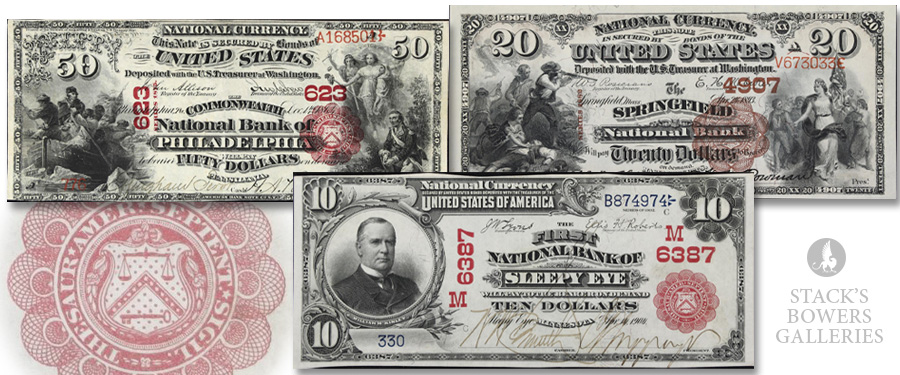
National Bank Notes have long been an object of interest and fascination to collectors. From the exotic National Gold Bank Notes issued in California during the 1870s to notes with a hometown connection, demand and interest has been consistent with a plethora of scholarship to match.
However, one question that I am consistently asked is something along the lines of “when was my National Bank Note issued?”
Date ranges vary from series to series, but a rough outline is provided below:
Original Series: 1863 – 1875
Series of 1875: 1875 – 1902
Series of 1882: 1882 – 1921
Series of 1902: 1902 – 1929
Series of 1929: 1929 – 1935
Take the Original Series for example. These notes can be dated using (1) the plate date which refers to when the face was plate engraved, and (2) the signatures of the cashier and president of the issuing bank. Even though a precise date may be impossible, these distinctions allow a collector to narrow down the timeframe to when that note was first released into circulation. Signatures are by far the best indicator, but engraved signatures, as encountered on later types like the Series of 1902 or Series of 1929, might not accurately reflect a concurrent tenure or an abrupt personnel change as banks might opt to exhaust existing stocks of unissued notes.
With the Series of 1902, the same logic can be applied to the three types issued under that series. However, for the Series of 1902 Plain Backs (which account for the last and largest number of surviving notes issued under that series), the Treasury Department did away with the dual accounting of Serial Numbers in 1925. Instead of an arrangement like 1 (Bank Serial Number)/B105036 (Treasury Serial Number) as encountered on a note we recently sold as part of our August 2024 Global Showcase Auction, the post-1925 arrangement would display the bank serial number twice. This arrangement would continue with the Series of 1929 which incorporated the plate position as well.
All notes issued under the Series of 1929 lack a plate date pertaining to when the face plate was engraved but can nonetheless be narrowed down to a specific timeframe based on signatures from the cashier and president and the fact that the Series of 1929 is represented by “Type I” and “Type II” notes. Type I notes were issued from June 1929 to May 1933 and represent the bulk of notes issued under the Series of 1929. Type II notes are fairly uncommon in comparison and can be identified by the fact that the charter number appears four times as opposed to two on their Type I counterparts.
Overall, when it comes to establishing a date range for any National Bank Note, tools like the U.S. National Bank Lookup (1863-1935) sponsored by the Society of Paper Money Collectors are invaluable in identifying signatures, as are period sources such as the Rand McNally Bankers Directory.
For more information about our auctions or to consign your numismatic items, please call 800-458-4646 or email Info@StacksBowers.com.





